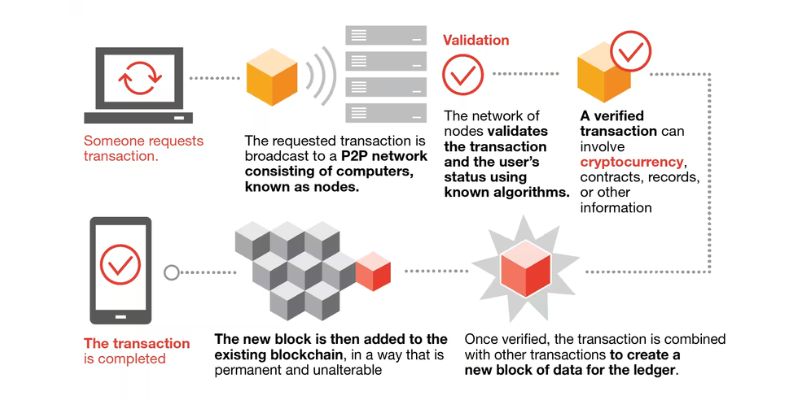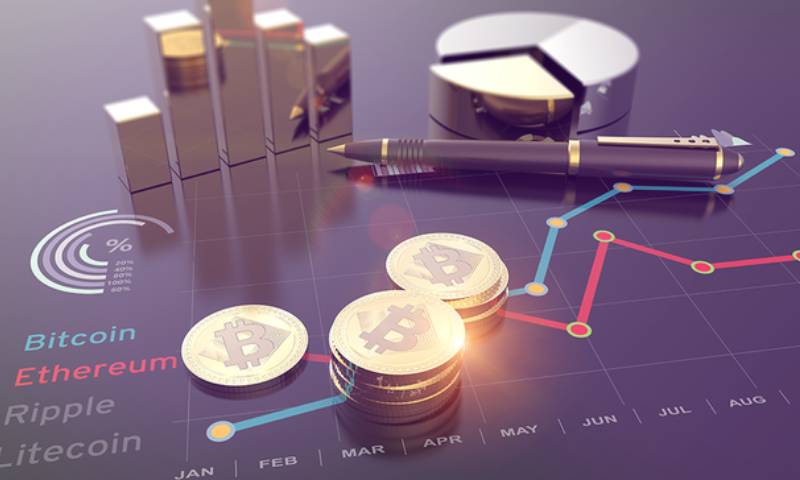‘Crypto’ buzzes on every tech tongue, but clarity often escapes us. Let’s cut to the chase: The difference between cryptocurrency and blockchain is essential yet misunderstood. I break it down simply; Cryptocurrency is money’s digital makeover, swift and global. Blockchain? It’s the brains behind the operation, a ledger keeping everyone honest. Think of crypto as the racecar and blockchain as the track: both cool, each unique. Dive in, as we untangle this digital knot right now.
Understanding the Core Concepts: Cryptocurrency and Blockchain Distilled
Defining Cryptocurrency and Its Role in Digital Transactions
Let’s kick things off by getting to the heart of cryptocurrency. Picture it as online cash you can use to buy stuff or send to friends. It’s a type of digital currency without any paper or coins to carry. It’s not made by any country’s government. Crypto coins are digital tokens used on the internet. Popular names like Bitcoin and Ethereum might ring a bell.
Each time you use cryptocurrency, the transaction gets locked in with complex math. It’s like locking something in a safe, but way more advanced! This math keeps your coins secure. A fun fact: you keep your crypto in a digital wallet, not in your back pocket.
Now, all this trading and moving digital money around happens super fast. It can go across the globe in moments, without using a bank. Pretty neat, right? But remember, with freedom comes risks. Cryptos can change in value very quickly. So while you can gain money, you might also lose it fast.
Unpacking Blockchain Fundamentals and Their Broader Implications
Okay, let’s dive into blockchain. Think of it as a magic notebook that everyone can see, but no one can erase or change what’s written. Everyone’s got a copy, so it’s super transparent. When you use a blockchain, you’re adding a page to that notebook for everyone to see.
This notebook is the tech behind cryptos like Bitcoin. It’s also used in tons of other cool ways. Think businesses, health care, and even voting! Blockchain can help track items, from where they’re made all the way to the store. It keeps things honest and out in the open.
There’s more to blockchain than just carrying cryptocurrency transactions. It can handle all sorts of information. Companies like this because it can make trading safer and smoother.
One key thing about the blockchain is that it’s decentralized. This means there’s no boss in charge. Instead, it’s a team game. People across the world help make sure every trade is correct. They use their computers to check and agree on updates to the notebook.
When they all agree, we call it “consensus.” It’s like everyone nodding their heads that everything’s right. In blockchain land, different kinds of consensus make sure the notebook’s pages are fair and square.
In all, the big deal about blockchain is trust. We can count on it to keep our info safe and play fair. It’s like having a guard watching over everything we do with it. But remember, it’s not just for online money. It’s a big puzzle piece for the internet’s future.
As we talk about blockchain and cryptocurrencies, we clear the digital knot. We see two powerful tools. Each with huge roles in how we trade and share on the web. They’re close friends but not twins. They open doors to an exciting, shared digital frontier.
Dissecting the Technical Mechanics: How They Operate Differently
Cryptography and Secure Transactions in Cryptocurrency Networks
Cryptocurrency is digital cash you can use to buy things. It’s kept safe by codes no one can crack. This fancy code-making is called cryptography. Cryptocurrencies live on a network that lets everyone’s computer hold a copy of all the transactions. This means that sending cryptocurrency to a friend is like an unbreakable secret message.
When you send crypto to someone, a special key scrambles the details. Only the person with the right key can open it and see. This makes sure no one else can take your digital cash. To keep these keys safe, we use something called wallets. They are like a digital piggy bank that no one can smash open.
Decentralized Ledger Technology: The Backbone of Blockchain
The blockchain, to put it simply, is a super list of all deals. These deals are about sending digital money like Bitcoin. But that’s not all it can do. A blockchain can hold all sorts of info, but let’s not make your head spin.
Think of blockchain like a giant Lego castle where everyone can see how it’s built. But, once a Lego brick goes on, you can’t take it off. This makes sure everything that happens is there forever and everyone agrees it’s true.
All the blocks in this chain are chunks of info. They stick together because of math problems that are really hard to solve. When someone solves one, they get some digital coins like a high-five. This hard math work is called mining, and it’s how new coins pop up.
So, you see, while cryptocurrency uses the blockchain, it’s just a part of it. Blockchain is the whole toy box where any game can happen. You can use it for more than just money. People are making games where you own stuff no one can steal. Or where you can prove who you are without showing your face!
Both cryptocurrency and blockchain are changing the way we think about money and trust. With them, we could make banks and paper cash a thing of the past. But it’s not just for buying video games or toys. Big companies use blockchain to track stuff they sell and make sure it’s real. It’s super useful, and the possibilities are as big as the stars. This is a place where anyone with a computer and an idea can create something new. It’s like being a wizard in the digital world!
Exploring Practical Applications: Use Cases and Innovations
Cryptocurrency as a Medium of Exchange and Investment
Let’s dive right into defining cryptocurrency. Cryptocurrency is a type of digital currency. People use it to buy things online or as an investment. Think of digital coins in a game, but you can actually use them to buy real stuff. There’s not just one kind. There are many types, like Bitcoin and Ethereum, which are the most well-known.
Understanding blockchain is key. It’s the tech that makes it all work. It’s like a ledger that everyone can see. It records every transaction with crypto coins. So when someone buys something with a cryptocurrency, blockchain keeps track. This helps make everything safe and everyone’s on the same page.
Because it works this way, cryptocurrency is really private. It uses special math called encryption. This keeps people’s information locked up tight. Only the right person can see or use it. So when you hear about crypto wallets, those are safe spots for people to keep their crypto coins.
Now, what about investing in cryptocurrency? Some folks hope the value of their digital coins goes up over time. Lots like to buy low and sell high. But it can be risky. The prices of cryptocurrencies can jump up and down a lot. That’s why understanding the crypto market is key for anyone looking to invest.
Blockchain Beyond Currency: Diverse Industry Transformations
Blockchain isn’t just for money. It’s huge across many businesses. Knowing how blockchain works lets us see why it’s so big now. Companies love blockchain. It lets them track shipments, from start to finish, without a mess. This is blockchain in the supply chain, making sure things move smoothly and honestly.
Remember, blockchain is a database that’s shared and trusted. It’s like a checkbook everyone at a meeting can see, to make sure all is fair. Blockchain platforms let businesses create apps that run on top of the blockchain. This is where smart contracts come in. They make deals between people without needing a middleman.
In finance, blockchain changes the game. It’s called decentralized finance, or DeFi for short. It lets people handle money, borrow, and lend without big banks in the deal. It’s a whole new world of doing money stuff directly between folks. No waiting in line. No extra fees. Just quick, straight-up money talks.
Blockchain also helps with keeping identities secure. It makes sure someone’s private info stays private. And it’s not just about keeping data safe. Blockchain’s trust makes it good for voting, knowing votes get counted right. Changes to the blockchain are tough, adding extra security.
What’s super cool about this tech is its many shapes. There are public blockchains, anyone can see. There are also private ones, just for certain eyeballs. Blockchain can also handle lots of info at once, which is called scalability. This lets it work well, even when it gets super busy.
Wrapping it up, blockchain creates loads of chances for cool new apps and ways of doing things. It’s not just for tech folks but for anyone curious about what the future of business looks like. Understanding these tools—blockchain and cryptocurrency—opens doors. Doors to new types of money, safer deals, and ways we haven’t even thought of yet.
Navigating the Ecosystem: Governance, Security, and Regulation
The Varied Landscape of Cryptocurrency Regulation and Oversight
Let’s talk about rules for crypto. One big question people ask is, “Who keeps crypto safe?” The answer is not simple. Different countries have different rules for crypto. In some places, it’s free like a bird. In others, it’s locked down tight. Each country decides how to handle crypto by making laws. Banks and governments keep an eye on it, just like your parents might watch you play at the park. Some rules make sure you don’t get mixed up in bad stuff like theft. Others help track where the money goes. Imagine your piggy bank had a log of every time you put money in or took it out. That’s kind of what crypto rules do.
Now, let’s get why we need rules. Without rules, bad guys could trick people and take their money. With rules, it’s like a big, strong fence keeps the play area safe. When you trade crypto, these rules help make sure nobody’s cheating. It also means when you grow up, you can still find your money where you left it.
Ensuring Integrity and Trust in Blockchain Networks Through Robust Security Measures
But wait, there’s more. We’ve got this cool thing called blockchain. Think of it like a magic notebook that never lies. Once you write something in it, nobody can erase it. That’s how blockchain keeps stuff safe. It’s a bunch of computers agreeing on who owns what. It’s super hard to trick, because you’d have to trick all the computers at once.
Every time someone buys or sells something with crypto, this magic notebook writes it down. That’s called a transaction. People all over the world help to make sure everything is written right, kind of like having the best hall monitors. They use special puzzles that are really, really hard to solve. This is what keeps the blockchain tough like a superhero. And if someone tries to mess with it, everyone will know.
Blockchain doesn’t just help with money. Businesses use it to track stuff like where your food comes from. This way, you know your apple didn’t take a crazy trip before it got to your lunchbox. Blockchain can be public, where everyone sees what’s going on. Or it can be private, like a secret club. Some blockchains even let you do smart deals that make themselves happen once everyone agrees. Imagine swapping toys with a friend, and a robot makes sure nobody backs out.
The cool part? As more people and businesses use blockchain, we find new ways to make stuff better. It’s like discovering new playground games. Maybe someday, you’ll make the rules that keep the digital world running smooth. Until then, remember this: cryptocurrency is all about trading digital money, but blockchain is the smart magic notebook that keeps track of everything.
So there you have it, folks! Crypto rules and blockchain security make sure the digital playground stays fun and fair for everyone. Keep this in mind next time you hear about bitcoin or use a computer. The digital world has its own ways of making sure everyone plays nice.
We’ve journeyed through the complex world of cryptocurrency and blockchain. Starting with the basics, we’ve defined crypto’s role and explored blockchain’s broad impact. We saw how crypto uses cryptography to keep our money safe and how blockchain acts as its strong backbone. We discovered that crypto isn’t just for buying things; it’s also an investment. And blockchain? It’s changing not just money, but whole industries.
We also tackled the rules and security that keep this tech in check. Remember, whether it’s new laws or power-packed safety, both are key to trust in these systems. My final thought? This is just the start. The tech will grow, and so will its role in our lives. Keep learning and stay curious – it’s a fast-moving world, and we’re all part of its story!
Q&A :
What is the fundamental difference between cryptocurrency and blockchain?
Blockchain acts as the underlying technology that enables the existence of cryptocurrencies (like Bitcoin, Ethereum, etc.). In essence, a blockchain is a distributed ledger that records all transactions across a network of computers. On the other hand, a cryptocurrency is a medium of exchange, like traditional currencies, but is digital and uses encryption techniques to control the creation of monetary units and to verify the transfer of funds.
How does blockchain technology support cryptocurrencies?
Blockchain technology supports cryptocurrencies by providing a secure and decentralized method of recording transactions. Every transaction made with a cryptocurrency is recorded on a block and then added to the chain of previous transactions, making a blockchain. This decentralized database, managed by multiple participants, is known as Distributed Ledger Technology (DLT). The security and integrity of the data in this ledger benefit from cryptographic hashing and consensus mechanisms like Proof of Work or Proof of Stake.
Can blockchain exist without cryptocurrency?
Yes, blockchain technology can exist without cryptocurrency. Although it is the foundational technology for all cryptocurrencies, blockchain has a wide variety of other applications, such as supply chain management, digital identity verification, and smart contracts. These applications can leverage the security, transparency, and immutability that blockchain provides without involving any form of digital currency.
Are all cryptocurrencies based on blockchain?
While most cryptocurrencies are based on blockchain technology, not all digital currencies use blockchain. There are alternative distributed ledger structures, such as Directed Acyclic Graphs (DAGs), that some cryptocurrencies use to record transactions and manage the ledger. However, blockchain remains the most well-known and widely used technology underlying the majority of cryptocurrencies in the market today.
Why is blockchain considered more than just the technology behind Bitcoin?
Blockchain is considered more than just the technology behind Bitcoin because it has potential uses that extend far beyond the realm of cryptocurrencies. It provides a secure and transparent way to conduct transactions and share information between parties who don’t necessarily trust each other, without the need for a centralized authority. This makes it valuable for many industries, including finance, healthcare, real estate, and more, leading to innovations like secure voting systems, transparent supply chain solutions, and automated legal agreements with smart contracts.






